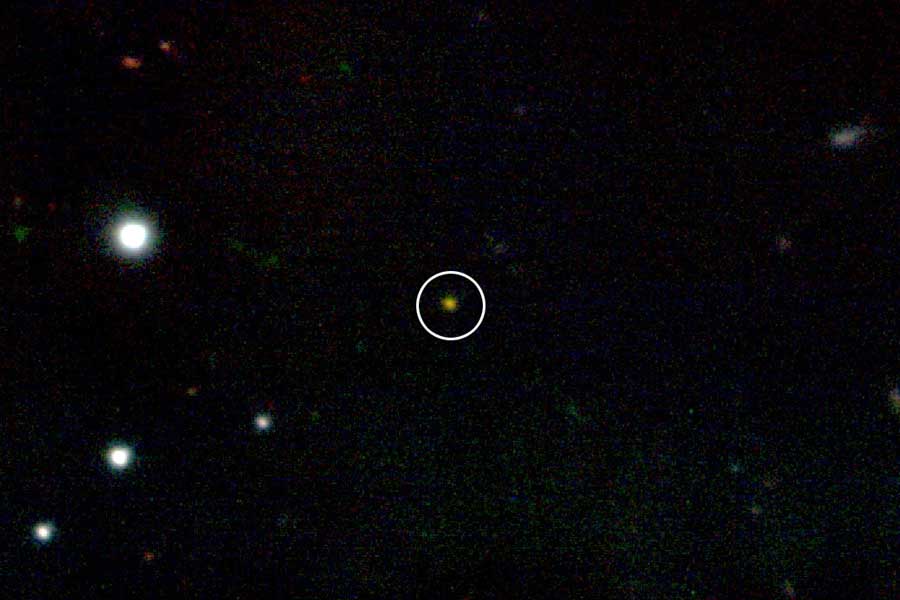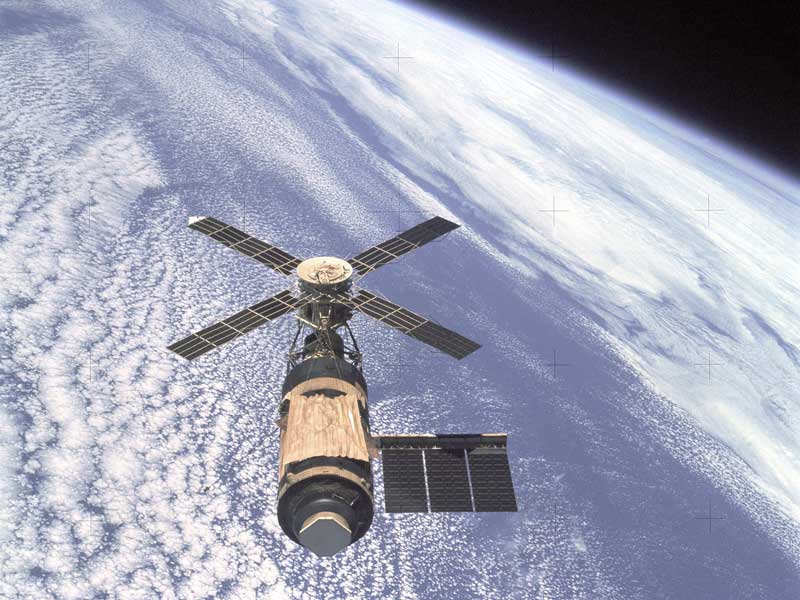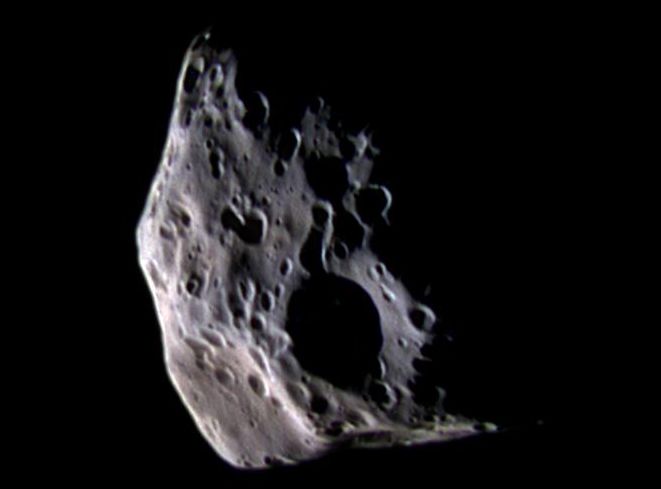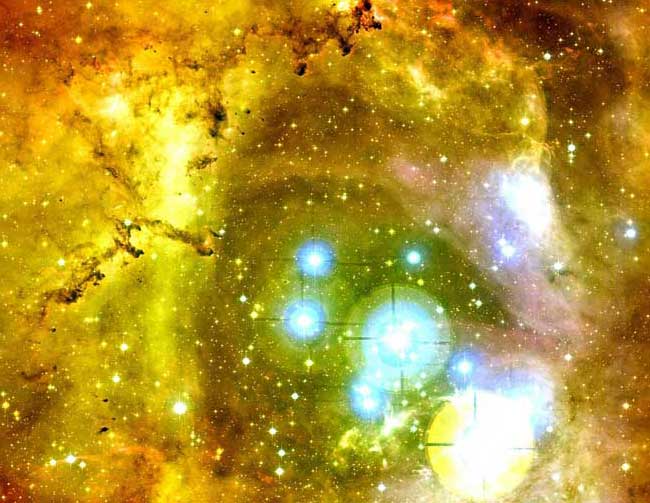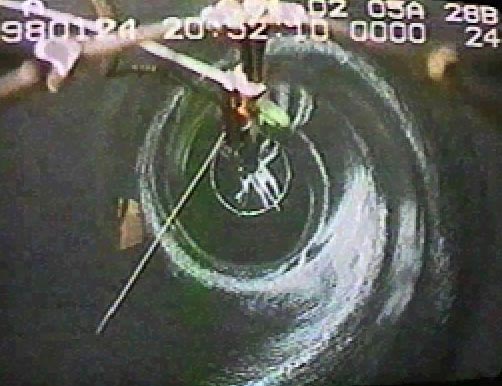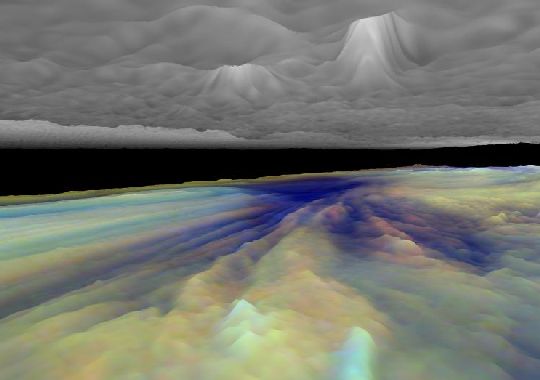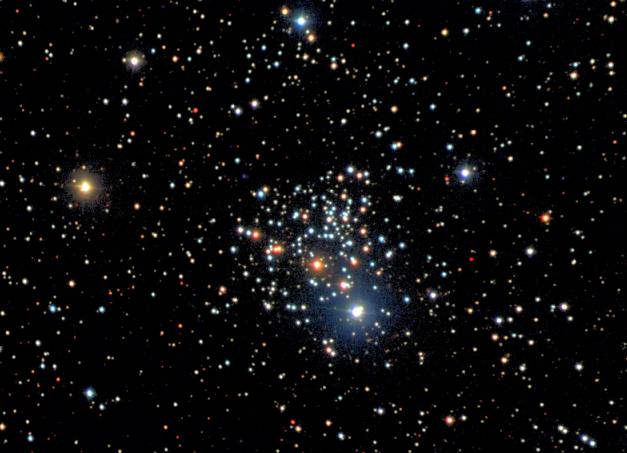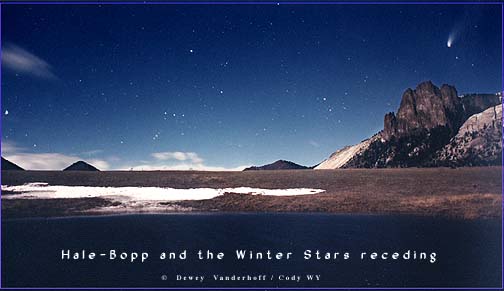| << Previous | Index | Next >> |
2015 What's happening to Comet 67P/Churyumov–Gerasimenko? As the 3-km wide comet moves closer to the Sun, heat causes the nucleus to expel gas and dust. The Rosetta spacecraft arrived at the comet's craggily double nucleus last July and now is co-orbiting the Sun with the giant dark iceberg. Recent analysis of data beamed back to Earth from the robotic Rosetta spacecraft has shown that water being expelled by 67P has a significant difference with water on Earth, indicating that Earth's water could not have originated from ancient collisions with comets like 67P. Additionally, neither Rosetta nor its Philae lander detected a magnetic field around the comet nucleus, indicating that magnetism might have been unimportant in the evolution of the early Solar System. Comet 67P, shown in a crescent phase in false color, should increase its evaporation rate as it nears its closest approach to the Sun in 2015 August, when it reaches a Sun distance just a bit further out than the Earth.
2014
[imghover6=http://apod.nasa.gov/apod/image/1404/au ... ck_960.jpg]http://apod.nasa.gov/apod/image/1404/au ... ed_960.jpg[/imghover6]Image Credit & Copyright: John Chumack
2013
[imghover6=http://apod.nasa.gov/apod/image/1304/st ... z_1440.jpg]http://apod.nasa.gov/apod/image/1304/st ... _1440c.jpg[/imghover6]Image Credit & Copyright: Daniel López (El Cielo de Canarias)
2012 On planet Gliese 876d, sunrises might be dangerous. Although nobody really knows what conditions are like on this close-in planet orbiting variable red dwarf star Gliese 876, the above artistic illustration gives one impression. With an orbit well inside Mercury and a mass several times that of Earth, Gliese 876d might rotate so slowly that dramatic differences exist between night and day. Gliese 876d is imagined above showing significant volcanism, possibly caused by gravitational tides flexing and internally heating the planet, and possibly more volatile during the day. The rising red dwarf star shows expected stellar magnetic activity which includes dramatic and violent prominences. In the sky above, a hypothetical moon has its thin atmosphere blown away by the red dwarf's stellar wind. Gliese 876d excites the imagination partly because it is one of the few extrasolar planets known to be in or near to the habitable zone of its parent star.
2011
2010 Barred spiral galaxy NGC 4731 lies some 65 million light-years away. The lovely island universe resides in the large Virgo cluster of galaxies. Colors in this well-composed, cosmic portrait, highlight plentiful, young, bluish star clusters along the galaxy's sweeping spiral arms. Its broad arms are distorted by gravitational interaction with a fellow Virgo cluster member, giant elliptical galaxy NGC 4697. NGC 4697 is beyond this frame above and to the left, but a smaller irregular galaxy NGC 4731A can be seen near the bottom in impressive detail with its own young blue star clusters. Of course, the individual, colorful, spiky stars in the scene are much closer, within our own Milky Way galaxy. NGC 4731 itself is well over 100,000 light-years across.
2009
2008
Click to play embedded YouTube video.
Credit & Copyright: Aaron Koblin, FAA
2007 The bright clusters and nebulae of planet Earth's night sky are often named for flowers or insects, and NGC 6302 is no exception. With an estimated surface temperature of about 250,000 degrees C, the central star of this particular planetary nebula is exceptionally hot though -- shining brightly in ultraviolet light but hidden from direct view by a dense torus of dust. Above is a dramatically detailed close-up of the dying star's nebula recorded by the Hubble Space Telescope. Cutting across a bright cavity of ionized gas, the dust torus surrounding the central star is in the upper right corner of this view, nearly edge-on to the line-of-sight. Molecular hydrogen has recently been detected in this hot star's dusty cosmic shroud. NGC 6302 lies about 4,000 light-years away in the arachnologically correct constellation Scorpius.
2006 Skylab was an orbiting laboratory launched by a Saturn V rocket in May 1973. Skylab, pictured above, was visited three times by NASA astronauts who sometimes stayed as long as two and a half months. Many scientific tests were performed on Skylab, including astronomical observations in ultraviolet and X-ray light. Some of these observations yielded valuable information about Comet Kohoutek, our Sun and about the mysterious X-ray background - radiation that comes from all over the sky. Skylab fell back to earth on 11 July 1979.
2005 Small saturnian moon Epimetheus (ep-ee-MEE-thee-us) is at most 116 kilometers across. Its cratered surface and irregular shape are highlighted by dramatic shadows in this composite close-up image from the Cassini spacecraft. However, orbiting 91,000 kilometers above Saturn's cloud tops, Epimetheus is not alone. Similar in size, saturnian moon Janus occupies an orbit separated from Epimetheus' by only about 50 kilometers. The two actually approach each other once every four years, but instead of colliding, the moons deftly exchange orbits and move apart again! In fact, co-orbiting Epimetheus and Janus both consist mostly of porous water ice and could have formed from the breakup of a single parent body. The small moons are also believed to play a role in maintaining the outer edge of Saturn's A ring.
2004 This June's rare and much heralded transit of Venus will feature our currently brilliant evening star in silhouette, as the inner planet glides across the face of the Sun. But on January 5, 2003 an even rarer transit took place. Titan, large moon of ringed gas giant Saturn, crossed in front of the Crab Nebula, a supernova remnant some 7,000 light-years away. During Titan's transit, the orbiting Chandra Observatory's x-ray detectors recorded the shadowing of cosmic x-rays generated by the Crab's amazing pulsar nebula, pictured above, in a situation analogous to a medical x-ray. The resulting image (inset at left) probes the extent of Titan's atmosphere. So, how rare was Titan's transit of the Crab? While Saturn itself passes within a few degrees of the Crab Nebula every 30 years, the next similar transit is reportedly due in 2267. And since the stellar explosion which gave birth to the Crab was seen in 1054, the 2003 Titan transit may have been the first to occur ... ever.
2003 In the heart of the Rosette Nebula lies a bright open cluster of stars that lights up the nebula. The stars of NGC 2244 formed from the surrounding gas only a few million years ago. This just-released image taken by the CFHT's new MegaPrime camera shows the region in unprecedented detail. Although the emission nebula is dominated by red hydrogen light, the above image has exaggerated the effect of green light emitted primarily by small amounts of oxygen. A hot wind of particles streams away from the cluster stars and contributes to an already complex menagerie of gas and dust filaments while slowly evacuating the cluster center. The Rosette Nebula's center measures about 50 light-years across, lies about 4500 light-years away, and is visible with binoculars towards the constellation of Monoceros.
2002
[imghover6=http://apod.nasa.gov/apod/image/0204/pl ... riguss.jpg]http://apod.nasa.gov/apod/image/0204/pl ... riguss.jpg[/imghover6]Credit & Copyright: Jerry Lodriguss
2001 Scientists are melting holes in the bottom of the world. In fact, several holes have been melted near the South Pole, and they are now being used as astronomical observatories. Astronomers with the Antarctic Muon and Neutrino Detector Array (AMANDA) lower into each vertical lake a string knotted with basketball-sized light detectors. The water in each hole soon refreezes. The detectors are sensitive to blue light emitted in the surrounding clear ice. Such light is expected from ice collisions with high-energy neutrinos emitted by objects or explosions out in the universe. The above picture was taken 750 meters below the surface looking down into the abyss. Instruments were lowered down past 2000 meters. Data from AMANDA is currently being collected and analyzed.
2000 Every day is a cloudy day on Jupiter, the Solar System's reigning gas giant. This 3-dimensional visualization presents a simplified model view from between Jovian cloud decks based on imaging and spectral data recorded by the Galileo spacecraft. The separation between the cloud layers and the height variations have been exaggerated. The upper cloud layer is haze a few tens of miles thick. Heights in the lower cloud layers have been color coded; light bluish clouds are high and thin, reddish clouds are low, and white clouds are high and thick. Streaks in the lower layer suggestively lead to a dark blue area, a relatively clear, dry region similar to the site where Galileo's atmospheric probe made the first entry into a gas giant planet's atmosphere on December 7th, 1995.
1999 The New General Catalog of star clusters and nebulae really isn't so new. In fact, it was published in 1888 - an attempt by J. L. E. Dreyer to consolidate the work of astronomers William, Caroline, and John Herschel along with others into a useful single, complete catalog of astronomical discoveries and measurements. Dreyer's work was successful and is still important today as this famous catalog continues to lend its acronym "NGC" to bright clusters, galaxies, and nebulae. Take for example this star cluster known as NGC 2266 (item number 2,266 in the NGC compilation). It lies about 10,000 light-years distant in the constellation Gemini and represents an open or galactic cluster. With an age of about 1 billion years, NGC 2266 is old for a galactic cluster. Its evolved red giant stars are readily apparent in this gorgeous three-color image.
1998 Giant spinning clouds of gas, similar to Earth's tornadoes, have been found on the Sun. Solar tornadoes, however, can be larger than the entire Earth, and sustain wind gusts over 1000 times stronger than their Earth counterparts. The SOHO spacecraft has found that solar tornadoes start low in the Sun's atmosphere and spiral outwards, gathering speed as they enter the Solar System. Earthlings have more to fear from Earth's own weather phenomena, though, because the high speed particles that result from solar tornadoes are easily stopped by the Earth's thick atmosphere. Earthlings may have much to learn from solar tornadoes, including details of how the solar wind and corona are powered, and how to better predict future solar particle storms that could damage sensitive satellites.
1997 Comet Hale-Bopp is still brighter than most constellations. In fact, Comet Hale-Bopp may now hold the record for staying bright the longest. Last week the comet was photographed above in the same field as the constellation Orion, visible in the photograph's center, as well as with Sirius, the brightest star in the night, visible on the far left. Just below Comet Hale-Bopp on the right is the volcanic caldera known as White Mountain.. As the comet heads south, it has become visible to most of the world, now including many observers in the Earth's Southern Hemisphere.
1996 Saturn's rings are actually very thin. This picture from the Hubble Space Telescope was taken on August 6, 1995 when the rings lined up sideways as seen from Earth. Saturn's largest moon Titan is seen on the left, and Titan's shadow can be seen on Saturn's cloud tops! Titan itself looks a brownish color because of its thick atmosphere. Four other moon's of Saturn can be seen just above the ring plane, which are, from left to right: Mimas, Tethys, Janus, and Enceladus. If you look carefully, you will note that the dark band across the planet is actually the shadow of the rings, and is slightly displaced from the real rings - which are best seen away from the planet. Saturn's rings are not solid - they are composed of ice chunks which range in size from a grain of sand to a house.
| << Previous | Index | Next >> |




